Certificates of Analysis

When you choose our kava you can rest assured that you will enjoy a product of the highest possible quality and purity. This is due not only to our commitment to sourcing only the best kavas processed in the best manner, but also because of the extremely advanced quality control process at the heart of our Vanuatu partners’ productuon process.
Our Vanuatu partners (Root and Pestle) ensure that each of our kava products is made from freshly harvested-to-order plants. Every batch undergoes rigorous analysis in our Vanuatu partners’ in-house lab to verify the correct morphological identification of cultivars and to record their specific chemical composition, ensuring safety.
As of June 2024, we are rolling out a database of our COAs containing PDFs with results from batches from March 2024 and onwards. We strive to keep this database as complete and up to date as possible, but please forgive us if some results are missing. If you need information, feel free to contact us. If we don't have it in PDF format, we should still be able to send you the raw data.
Understanding Kava Chemotypes and Certificates of Analysis (COAs)
Kava contains various chemical compounds known as kavalactones. These kavalactones are responsible for the psychoactive effects of kava, and their composition can vary significantly between different cultivars and batches. This unique chemical composition is referred to as the "chemotype" of the kava.
What is a Chemotype?
A chemotype is essentially the unique chemical fingerprint of a kava plant. It indicates the relative abundance of six major kavalactones: desmethoxyyangonin, dihydrokavain, yangonin, kavain, dihydromethysticin, and methysticin. These are often labeled numerically from 1 to 6. For example, a chemotype listed as 243156 indicates the relative abundance of these compounds in that specific order. The chemotype can significantly influence the physiological and psychological effects experienced by the user.
What is a Certificate of Analysis (COA)?
A Certificate of Analysis (COA) provides detailed information about the chemical and microbiological composition of a specific batch of kava. It includes the chemotype, which helps consumers understand the kavalactone profile, and can indicate the likely effects of the kava. Additionally, COAs typically include microbiological data to ensure the product is safe for consumption.
Interpreting Our COAs
Our COAs provide comprehensive information about each batch of kava. For example, the COA for Bir Kar Instant can include the following key details:
-
Chemotype: 423165, indicating the relative abundance of the six major kavalactones.
-
Total Extracted Major Kavalactones: 7.81% of the kava mass, giving an idea of the potency.
-
Microbiological Analysis: Tests for contaminants like coliforms, E. coli, yeast, mold, and pathogens such as Salmonella and Listeria, ensuring the kava meets safety standards.
Find Your Certificate of Analysis (COA)
Enter your product details and best before date from your package to find the corresponding COA document.



